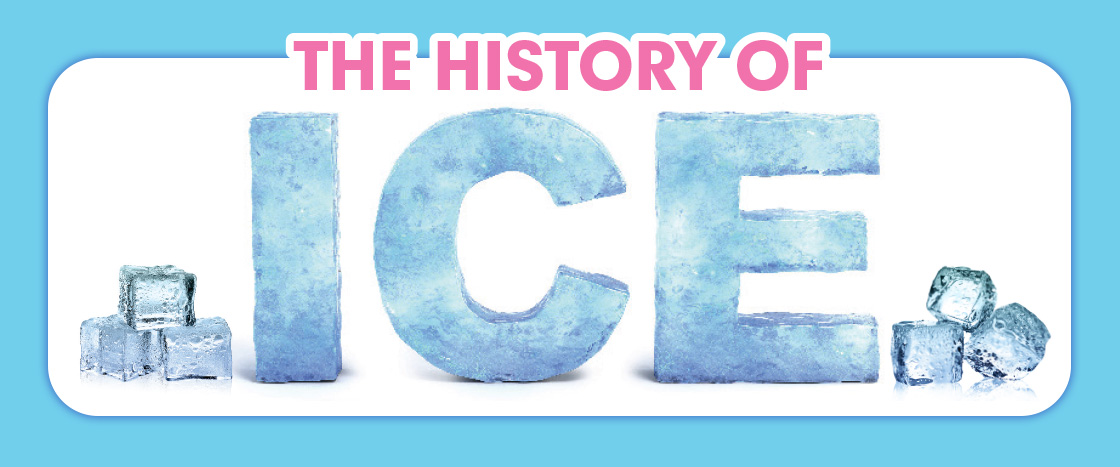Clink! Have you ever put ice in a glass of water? Today ice is a normal part of our lives. But long ago, ice was hard to get.

Standards
Ice From Mountains
Two thousand years ago, there were no freezers. In ancient Rome, people had to climb up snowy mountains to get ice! It was dangerous work.
They stored the ice in pits lined with straw. The straw kept the ice insulated. That means it kept cold air in and hot air out.
People used ice to keep their food fresh. They also mixed ice with juice or honey to make slushies. Yum!
Ice From Rivers and Lakes
In the 1800s, people got ice from frozen rivers and lakes. They cut out big blocks of ice with huge saws. They had to work during the winter.
Sometimes they worked all night. They used candles to see.
They stored ice in buildings called icehouses. Icehouses were insulated. They could keep ice frozen all summer.
During this time, people used ice to keep food cold. They also made ice cream with the ice! Ice cream was a very special treat because ice was so hard to get.
Iceboxes
By 1900, many people had iceboxes in their homes. Have you ever used a cooler at a picnic? An icebox was like a cooler.
Horse-drawn carriages brought big blocks of ice to people’s houses. Workers called icemen and icewomen picked up the blocks of ice with strong clamps.
Sometimes the icemen and icewomen would give kids small pieces of ice to suck on.
Freezers
By 1950, most people in the U.S. had electric freezers, like the ones we use today. Now we can make our own ice in the freezer with ice cube trays or ice makers.
It’s way easier than climbing a mountain or working all night to get ice!
Ice Timeline
SMITH ARCHIVE/ALAMY STOCK PHOTO (FROZEN LAKE); ASAR STUDIOS/ALAMY STOCK PHOTO (ICE DELIVERY); SHUTTERSTOCK.COM (ALL OTHER IMAGES)
2,000 years ago: People got ice from mountains.
1800s: People got ice from frozen lakes.
1900s: Icemen and icewomen delivered ice.
Today: Now people use ice cube trays to make ice.
About the Article
Social Studies Focus
Technology changes over time
Vocabulary
pits, insulated, icehouses, iceboxes, carriages, clamps
Essential Question
The essential question of this issue is: What happens in cold places?
The articles below connect to this theme.
- Background Builder: “A Frozen Land,” p. 4
- Big Read: “Escape from the Ice,” p. 6
- Word Play: “3 Ways to Say Cold,” p. 12
- Past to Present: “The History of Ice,” p. 22
- Fiction: “The Snow Day,” p. 24
- Poetry: “Snow Mail,” p. 32
Through the above texts, students will dig deep into this essential question and make text-to-text connections.
1. BEFORE READING
Show “The Big Question” Video (10 minutes)
Watch “The Big Question: What happens in cold places?” (This video also goes with other stories in this month’s Storyworks 2.)
- Before your students watch, ask them to think about the question “What happens in cold places?”
- Watch the video.
- After watching, ask the question again. Write students’ ideas on chart paper.
Preview the Vocabulary (3-5 minutes)
- Play the online vocabulary slideshow. This article’s featured words are pits, insulated, icehouses, iceboxes, carriages, and clamps.
Text Preview Bookmarks (5-10 minutes)
- Our skills page has both fiction and nonfiction options for kids to cut out to help them preview the text. They can use the nonfiction bookmark for this story.
2. READ THE ARTICLE (10 MINUTES)
- Now tell students they are going to read an article about the history of tacos. Students can read the article individually, in small groups, or as a whole class.
3. AFTER READING: FOCUS ON ELA SKILLS (10 MINUTES)
Assessment: Quiz (10 minutes)
- Pass out the quiz to assess comprehension.
- We offer this quiz in multiple-choice and written-answer formats.
ELA Focus: Parts of Speech (15 minutes)
- Using the “History of Ice Web” printable, students can look back at the text and summarize key details.
Enrich the Learning: Paired Text Opportunities (time amount varies)
- Making text-to-text connections builds knowledge and comprehension. We layer Storyworks 2 with many ways for your students to make connections.
Pairable Texts: the Background Builder,
“A Frozen Land” (page 4); the Big Read, “Escape from the Ice” (page 6); the Word Play, “3 Ways to Say Cold” (page 12); the Fiction, “The Snow Day” (page 24); and the Poetry kit, “Snow Mail” (page 32)
- Kids can compare the texts by using our “Chilly Chart” printable. How are the texts alike, and how are they different?
Whole Issue Scavenger Hunt (20 minutes)
We created a scavenger hunt for several stories in this month’s Storyworks 2, including this nonfiction piece. The scavenger hunt can be done by students independently at home or during class time.
This is a self-contained group of slides that guide your students on a scavenger hunt through the whole issue. It’s not only fun, it also helps them make text-to-text connections.
To find it, look in your Resources section. Scroll down to Activities. You will see it there.To find it, look in your Resources section. Scroll down to Activities. You will see it there.
